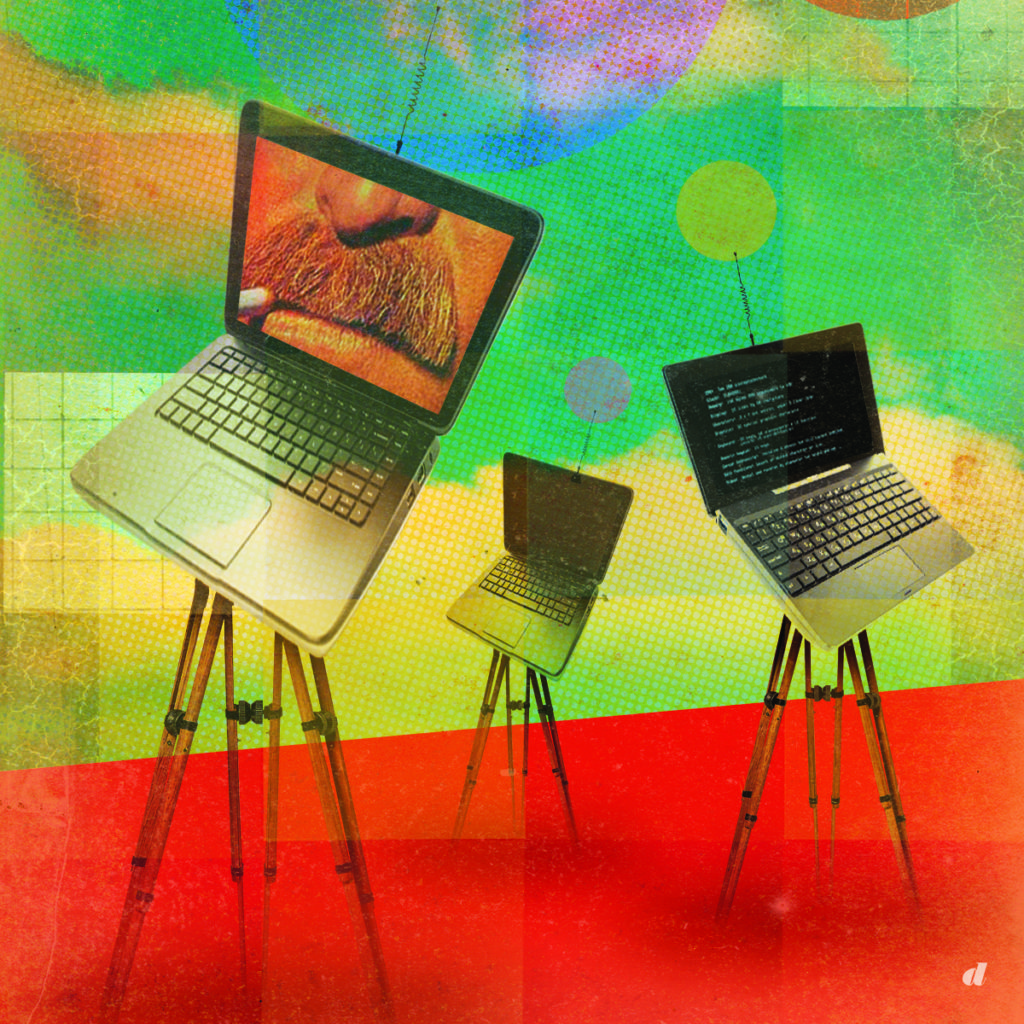
I smoked my first cigarette when I was seven. Too cautious to steal one from my mother’s purse, I persuaded my babysitter to give me one of hers instead. Of course, she hesitated, laughing at me from behind a cloud of smoke. “You’re cute, kid,” she said as her pet iguana blinked at me from the couch behind her. But I presented what I believed to be a very logical argument—“If you’re going to smoke right next to me, I’m breathing in all your smoke anyway,” I said. “I should just have my own.” She didn’t offer a counterargument. Instead, she flipped open her pack and offered it to me.
I held the slim white cigarette in my hand, marveling at the reddish-brown tobacco at the tip and the word “Marlboro” printed in tiny black letters just above the filter. “Breathe deep,” she instructed as she flicked her lighter on and brought it toward my face. Then she slumped back on her couch and began painting her iguana’s claws to match the bright pink on her own toes. I was firmly resolved not to choke, aware that this rookie mistake might cost me my cigarette.
It didn’t taste the way I’d imagined it would, though. Whenever I watched my mother smoke she’d tilt her head back with each puff, holding it in her mouth for a while before releasing a slow stream of smoke that hung in the air like a cobweb. Then she’d lick her lips, as if she were savoring the flavor of the thing. I was surprised by the pleasurable burn I felt at the back of my throat, and the sour, peppery taste that lingered in my mouth long after I was finished. It wasn’t so much the taste, or even curiosity, that prompted me—it was the Marlboro Man.
After catching a glimpse of the Marlboro Man on horseback lassoing a steer with one hand and lighting a cigarette with the other, my mother had promptly switched her brand from Salem to Marlboro. “Isn’t he handsome?” she’d ask each time she spotted some version of him on a billboard or magazine. She had a type, my mother—tanned skin, soulful eyes, somewhat aloof. My stepfather bore a resemblance to the Marlboro Man with his honeyed hue and strong chin, but his everydayness, by comparison, seemed to dull even his complexion. He was an impersonator, a stand-in for a father. But there was nothing phony about the Marlboro Man.
It was obvious from the start that my stepfather was my sister Amanda’s biological father. She had his deep brown eyes, tawny complexion, and dark hair—so different from me and my mother with our fair features. Never having known my own father, I wondered if there was a man in the world walking around with my face, if I’d run into him some day and know instantly that I belonged to him. “You look just like me,” my mother would say whenever I asked her about him. “That’s all that matters.”
In grade school, I was only ever able to complete one side of my family tree assignments. And in the blank space that blinked at me from the other side, I’d imagine a man with a cigarette tucked beneath his reddish-brown mustache, a Stetson hat tipped low over one eye so that it cast a shadow on his face.
My mother had always insisted she wasn’t sure who my father was. Sometimes she’d list a few names and give a detailed account of her escapades with these men, but she’d always find a reason why I couldn’t belong to any of them. Their hair was too dark, chin too broad, eyes too close together. As the years went by, however, the list of names was whittled down until there was only one: Frank Riggio.
“I think I always knew it was him,” she finally told me a few weeks before my eighteenth birthday. When I asked why she hadn’t told me sooner, why she’d strung me along for so long, she simply shrugged her shoulders and poured herself a glass of wine. And there began my quest to find the man I thought I’d never find, who was never quite real to me.
I spent weeks looking up Frank’s name in the phone book. There were precisely 13 Frank Riggios in Baltimore alone and there was no guarantee that he’d still be living in the area. I called each of them, thinking that maybe I’d be able to tell from the sound of his voice whether or not he was mine. But each time I heard “hello” at the other end of the line, I hung up. It wasn’t until I spent the night at my friend J’s house that I finally had a breakthrough.
“Why don’t you just look him up on MySpace?” she offered. “Everyone’s on MySpace.”
“Except me, apparently,” I said.
“So make a profile. See what happens.”
She helped me choose a few photos and fill in the necessary information. Then I typed his name in the search box. My hand hovered for a while over the enter button, the reality of it all finally hitting me. I was just a click away from finding a man I thought I’d never meet.
There were only a handful of results—a teenage boy in California, a few college bros in hoodies and baseball caps, and a man in his late forties living in Ona, West Virginia. It had to be him. I studied his face for a while, hoping to find a trace of myself there. His nose was wide, like mine, and his hair (what was left of it) the same golden brown. Until this moment his face had been a question mark, a collage of all the TV fathers I had watched.
I sent him a message: “Did you know a woman named Patty Campbell in the late 80s?” I held J’s hand the whole time, and we checked the inbox again every hour.
It wasn’t until the next day that I got his response: “Yes, I did.”
Of all the ways I had imagined this conversation going, I never expected that we’d be reuniting hundreds of miles apart. I pictured a fancy Italian restaurant, tears over cannoli, a warm (if not awkward) embrace. Instead, I got a computer screen.
“I think I’m your daughter,” I said. “I don’t need anything from you, I just want to know for sure.”
In the two days it took for Frank to get back to me, I was certain that I’d frightened him off. It had to be quite a shock for him. It felt dizzying even for me, though I’d had almost two decades to prepare. I wondered then if I was being selfish inserting myself into his life like this. How would his family feel? Was he better off having not known about me?
His response wasn’t what I expected. “I had a feeling,” he said. “About a year after your mother and I stopped … getting together … I saw her in the grocery store with a baby. One of her friends mentioned that it might be mine.” I felt a wave of heat move through my body, settling in my cheeks. I was suddenly an outsider in my own story, a long game of telephone that had finally made its way to the end of the line.
My mother laughed when I told her. “Oh, that’s right,” she said casually, as if she were just remembering that she’d left clothes in the dryer. “Now that I think about it, I guess he must have known.” It was a secret she had kept even from herself.
Frank seemed eager to get to know me. He asked me for baby pictures, which I gladly sent, and he told me how much I looked like his sister when she was a child. He sent photos of his mother, his teenage son, his five-year-old triplets. “I guess … this is your family, too,” he said. “Your grandmother, your brothers and your sister.” He also attached a photo of himself from the late ’80s, his hair styled in a neat mullet. But he had well-defined arms and a muscular build. “I used to lift some weights,” he confessed.
My mother told me he had actually won the title of “Mr. Maryland” in the mid-80s, a semi-professional bodybuilding competition. “He was really, really good looking,” she said. “We used to get together at this bar in Highlandtown a few times a week, and then head back to his place. We’d do some coke, and then he would just pound me,” she said, smashing her right fist into the palm of her left hand. “After that I’d just watch him do a bunch of bench presses.”
When the DNA “kit” arrived, it was in a handwritten envelope that contained a cotton swab, a plastic bag, and a paragraph-long explanation about how I was to swab the inside of my cheek. There was a short form to fill out and send in along with the swab. The company was called simply “Genetic Testing Laboratories, Inc.,” and the logo on their letterhead was a generic clip-art version of a test tube. So, I placed the slimy swab in the plastic bag and sent it off to the company’s New Mexico P.O. Box address.
Though I had my misgivings about the process, I was confident that the results would come back positive. So was Frank. He was scheduling a time when we could get together for dinner. For me, the test was about more than closure. It was like a new birth certificate, a legitimizing. It was a concrete tie that I would have to my father and my new family. My younger sister and I had been on rocky ground since we were children. I made so many mistakes with her that I looked forward to a fresh start. I could do things right with these shiny new siblings.
While we were waiting for the lab to send us their findings, I noticed that Frank’s profile disappeared from MySpace. I asked him about it, but he was cryptic. “Issues at home … long story, I may fill you in later.” The next day, I received a clipped email from him that said, “Results negative. Sorry.” I was stunned.
I reached out to him a few days later, trying to choose my words carefully. “Are you sure?” I asked. That question rested on a mountain of other questions: Had he read the results correctly? Were our samples contaminated? Did we take the samples the right way? Was this test even legit? “Yes,” he said. “I’m positive,” he said. There was nothing left for me to do. I apologized for upending his life and for wasting his time. Then I received my last email from Frank. “That is ok … I wish you all of the best throughout your life … take care.”
Months later, when I was helping her navigate her new computer, I discovered that my mother had been emailing Frank, too. At first they talked mostly about me—what I had been like as a child, milestone moments, what my interests were. But then they began to reminisce. Their shared past and old exploits made for exciting conversation. They quickly remembered the intricacies of one another’s bodies, and the places they liked to be touched. They confessed that they were both unhappy in their marriages. They wondered if they might still have the spark they had 20 years ago. Plans were made to meet at a halfway point, but his wife found the emails and put a kibosh on the whole thing. “It’s just as well,” my mother said. “Gas is so expensive these days.”
Every other year now, like clockwork, Frank reaches out to me on some social media platform to check in and see how I’m doing. He tells me a little about his life, too. He divorced his wife, he said, married again, and bought a small house near the ocean. I told him I got married too, that I began teaching, and he said he was happy for me. He suggested that he would be open to another DNA test once, saying, “I did have a feeling before that the test was going to come back with a different result since I did see a resemblance in your photos.”
Despite Frank’s offer, I still haven’t taken him up on the chance for another test. Sure, I want closure, but there is some part of me that wonders if the idea of a father isn’t better than a flesh-and-blood version. I think of all the wonderful men who’ve been in my life all along, who’ve fathered me in one way or another—a beloved uncle who took me into his home and sent me to college, a grandfather who introduced me to operas and musicals and insisted I read every book in his house, a father-in-law who patches holes in walls and tells stories of his travels all over the world—and I wonder, what’s in a name like “father?” This way, when I imagine that blank space blinking at me from one side of my family tree, I can fill it in any way I like.




